An Approach Towards Optimization Appraisal of Thermal Conductivity of Magnetic Thermoplastic Elastomeric Nanocomposites Using Response Surface Methodology
Abstract
1. Introduction
2. Materials and Methods
2.1. Materials and Preparation
2.2. Preparation of Magnetic-TPNR Nanocomposites
2.3. Characterization
2.4. Statistical Design of Experiments
3. Results and Discussion
3.1. Morphological Analysis
3.2. Mathematical Model Construction and Validation
3.3. Response Optimization of the Thermal Conductivity of the Nanocomposites
3.4. Experimental Verification of the Predicated Optimum Condition
4. Conclusions
Funding
Acknowledgments
Conflicts of Interest
References
- Idumah, C.I.; Hassan, A. Recently emerging trends in thermal conductivity of polymer nanocomposites. Rev. Chem. Eng. 2016, 32, 413–457. [Google Scholar] [CrossRef]
- Feng, C.P.; Wan, S.S.; Wu, W.C.; Bai, L.; Bao, R.Y.; Liu, Z.Y.; Yang, M.B.; Chen, J.; Yang, W. Electrically insulating, layer structured SiR/GNPs/BN thermal management materials with enhanced thermal conductivity and breakdown voltage. Compos. Sci. Technol. 2018, 167, 456–462. [Google Scholar] [CrossRef]
- Ouyang, Y.; Li, X.; Ding, F.; Bai, L.; Yuan, F. Simultaneously enhance thermal conductive property and mechanical properties of silicon rubber composites by introducing ultrafine Al2O3 nanospheres prepared via thermal plasma. Compos. Sci. Technol. 2020, 190, 108019. [Google Scholar] [CrossRef]
- Pan, C.; Kou, K.; Wu, G.; Zhang, Y.; Wang, Y. Fabrication and characterization of AlN/PTFE composites with low dielectric constant and high thermal stability for electronic packaging. J. Mater. Sci. Mater. Electron. 2016, 27, 286–292. [Google Scholar] [CrossRef]
- Nayak, S.K.; Mohanty, S.; Nayak, S.K. Thermal, Electrical and Mechanical Properties of Expanded Graphite and Micro-SiC Filled Hybrid Epoxy Composite for Electronic Packaging Applications. J. Electron. Mater. 2020, 49, 212–225. [Google Scholar] [CrossRef]
- Flaifel, M.H.; Zakaria, M.Z.; Ahmad, S.H. The Influence of Adopted Chemical Modification Route on the Thermal and Mechanical Properties of Alumina Nanoparticles-Impregnated Thermoplastic Natural Rubber Nanocomposite. Arab. J. Sci. Eng. 2020, 45, 1181–1190. [Google Scholar] [CrossRef]
- Jones, W.E.; Chiguma, J.; Johnson, E.; Pachamuthu, A.; Santos, D. Electrically and thermally conducting nanocomposites for electronic applications. Materials 2010, 3, 1478–1496. [Google Scholar] [CrossRef]
- Zhang, Y.; Choi, J.R.; Park, S.J. Enhancing the heat and load transfer efficiency by optimizing the interface of hexagonal boron nitride/elastomer nanocomposites for thermal management applications. Polymer (Guildf) 2018, 143, 1–9. [Google Scholar] [CrossRef]
- Kalia, S.; Kango, S.; Kumar, A.; Haldorai, Y.; Kumari, B.; Kumar, R. Magnetic polymer nanocomposites for environmental and biomedical applications. Colloid Polym. Sci. 2014, 292, 2025–2052. [Google Scholar] [CrossRef]
- Singh, J.; Srivastava, M.; Dutta, J.; Dutta, P.K. Preparation and properties of hybrid monodispersed magnetic α-Fe2O3 based chitosan nanocomposite film for industrial and biomedical applications. Int. J. Biol. Macromol. 2011, 48, 170–176. [Google Scholar] [CrossRef]
- Purushotham, S.; Ramanujan, R.V. Thermoresponsive magnetic composite nanomaterials for multimodal cancer therapy. Acta Biomater. 2010, 6, 502–510. [Google Scholar] [CrossRef] [PubMed]
- Ngo, T.D.; Le, T.M.H.; Nguyen, T.H.; Nguyen, T.V.; Nguyen, T.A.; Le, T.L.; Nguyen, T.T.; Van Tran, T.T.; Le, T.B.T.; Doan, N.H. Antibacterial Nanocomposites Based on Fe3O4-Ag Hybrid Nanoparticles and Natural Rubber-Polyethylene Blends. Int. J. Polym. Sci. 2016, 2016, 1–9. [Google Scholar] [CrossRef]
- Yuan, Q.; Venkatasubramanian, R.; Hein, S.; Misra, R.D.K. A stimulus-responsive magnetic nanoparticle drug carrier: Magnetite encapsulated by chitosan-grafted-copolymer. Acta Biomater. 2008, 4, 1024–1037. [Google Scholar] [CrossRef]
- Ahmad, S.H.; Nasef, M.M.; Abdullah, M.H.; Flaifel, M.H. Magnetic polymeric nanocomposite materials: Basic principles preparations and microwave absorption application. Adv. Funct. Polym. Compos. 2013, 1, 81–121. [Google Scholar]
- Zhan, Y.; Wang, J.; Zhang, K.; Li, Y.; Meng, Y.; Yan, N.; Wei, W.; Peng, F.; Xia, H. Fabrication of a flexible electromagnetic interference shielding Fe3O4@reduced graphene oxide/natural rubber composite with segregated network. Chem. Eng. J. 2018, 344, 184–193. [Google Scholar] [CrossRef]
- Idris, F.M.; Hashim, M.; Abbas, Z.; Ismail, I.; Nazlan, R.; Ibrahim, I.R. Recent developments of smart electromagnetic absorbers based polymer-composites at gigahertz frequencies. J. Magn. Magn. Mater. 2016, 405, 197–208. [Google Scholar] [CrossRef]
- Jiang, D.; Murugadoss, V.; Wang, Y.; Lin, J.; Ding, T.; Wang, Z.; Shao, Q.; Wang, C.; Liu, H.; Lu, N.; et al. Electromagnetic Interference Shielding Polymers and Nanocomposites—A Review. Polym. Rev. 2019, 59, 280–337. [Google Scholar] [CrossRef]
- Boon, M.S.; Serena Saw, W.P.; Mariatti, M. Magnetic, dielectric and thermal stability of NiZn ferrite-epoxy composite thin films for electronic applications. J. Magn. Magn. Mater. 2012, 324, 755–760. [Google Scholar] [CrossRef]
- Wei, H.G.; Wang, H.; Li, A.; Cui, D.P.; Zhao, Z.N.; Chu, L.Q.; Wei, X.; Wang, L.; Pan, D.; Fan, J.C.; et al. Multifunctions of Polymer Nanocomposites: Environmental Remediation, Electromagnetic Interference Shielding, And Sensing Applications. ChemNanoMat 2020, 6, 174–184. [Google Scholar] [CrossRef]
- Ramirez, S.; Chan, K.; Hernandez, R.; Recinos, E.; Hernandez, E.; Salgado, R.; Khitun, A.G.; Garay, J.E.; Balandin, A.A. Thermal and magnetic properties of nanostructured densified ferrimagnetic composites with grapheme—Graphite fillers. Mater. Des. 2017, 118, 75–80. [Google Scholar] [CrossRef]
- Ma, Y.; Hou, C.; Zhang, H.; Zhang, Q.; Liu, H.; Wu, S.; Guo, Z. Three-dimensional core-shell Fe3O4/Polyaniline coaxial heterogeneous nanonets: Preparation and high performance supercapacitor electrodes. Electrochim. Acta 2019, 315, 114–123. [Google Scholar] [CrossRef]
- Weidenfeller, B.; Höfer, M.; Schilling, F. Thermal and electrical properties of magnetite filled polymers. Compos. Part A Appl. Sci. Manuf. 2002, 33, 1041–1053. [Google Scholar] [CrossRef]
- Flaifel, M.H.; Ahmad, S.H.; Hassan, A.; Bahri, S.; Tarawneh, M.A.; Yu, L.J. Thermal conductivity and dynamic mechanical analysis of NiZn ferrite nanoparticles filled thermoplastic natural rubber nanocomposite. Compos. Part B Eng. 2013, 52, 334–339. [Google Scholar] [CrossRef]
- Kim, K.; Kim, J. Magnetic aligned AlN/epoxy composite for thermal conductivity enhancement at low filler content. Compos. Part B Eng. 2016, 93, 67–74. [Google Scholar] [CrossRef]
- Flaifel, M.H.; Ahmad, S.H.; Abdullah, M.H.; Rasid, R.; Shaari, A.H.; El-Saleh, A.A.; Appadu, S. Preparation, thermal, magnetic and microwave absorption properties of thermoplastic natural rubber matrix impregnated with NiZn ferrite nanoparticles. Compos. Sci. Technol. 2014, 96, 103–108. [Google Scholar] [CrossRef]
- Yu, L.J.; Ahmad, S.H.; Appadu, S.; Kong, I.; Tarawneh, M.A.; Flaifel, M.H. Comparison of magnetic and microwave absorbing properties between multiwalled carbon nanotubes nanocomposite, nickel zinc ferrite nanocomposite and hybrid nanocomposite. World J. Eng. 2014, 11, 317–322. [Google Scholar] [CrossRef]
- Myers, R.H.; Montgomery, D.C.; Anderson-Cook, C.M. Response Surface Methodology: Process and Product Optimization Using Designed Experiments; John Wiley & Sons: Hoboken, NJ, USA, 2016. [Google Scholar]
- Baniassadi, M.; Laachachi, A.; Hassouna, F.; Addiego, F.; Muller, R.; Garmestani, H.; Ahzi, S.; Toniazzo, V.; Ruch, D. Mechanical and thermal behavior of nanoclay based polymer nanocomposites using statistical homogenization approach. Compos. Sci. Technol. 2011, 71, 1930–1935. [Google Scholar] [CrossRef]
- Ashenai Ghasemi, F.; Daneshpayeh, S.; Ghasemi, I.; Ayaz, M. An investigation on the Young’s modulus and impact strength of nanocomposites based on polypropylene/linear low-density polyethylene/titan dioxide (PP/LLDPE/TiO2) using response surface methodology. Polym. Bull. 2016, 73, 1741–1760. [Google Scholar] [CrossRef]
- Ashenai Ghasemi, F.; Ghasemi, I.; Menbari, S.; Ayaz, M.; Ashori, A. Optimization of mechanical properties of polypropylene/talc/graphene composites using response surface methodology. Polym. Test. 2016, 53, 283–292. [Google Scholar] [CrossRef]
- Mortazavi, B.; Hassouna, F.; Laachachi, A.; Rajabpour, A.; Ahzi, S.; Chapron, D.; Toniazzo, V.; Ruch, D. Experimental and multiscale modeling of thermal conductivity and elastic properties of PLA/expanded graphite polymer nanocomposites. Thermochim. Acta 2013, 552, 106–113. [Google Scholar] [CrossRef]
- Seyed Dorraji, M.S.; Rasoulifard, M.H.; Amani-Ghadim, A.R.; Khodabandeloo, M.H.; Felekari, M.; Khoshrou, M.R.; Hajimiri, I. Microwave absorption properties of polypyrrole-SrFe12O19-TiO2-epoxy resin nanocomposites: Optimization using response surface methodology. Appl. Surf. Sci. 2016, 383, 9–18. [Google Scholar] [CrossRef]
- Davodi, B.; Ghorbani, M.; Jahangiri, M. Adsorption of mercury from aqueous solution on synthetic polydopamine nanocomposite based on magnetic nanoparticles using Box–Behnken design. J. Taiwan Inst. Chem. Eng. 2017, 80, 363–378. [Google Scholar] [CrossRef]
- Hamadneh, N.N.; Khan, W.S.; Khan, W.A. Prediction of thermal conductivities of polyacrylonitrile electrospun nanocomposite fibers using artificial neural network and prey predator algorithm. J. King Saud Univ.-Sci. 2019, 31, 618–627. [Google Scholar] [CrossRef]
- Al-Qubaisi, M.S.; Rasedee, A.; Flaifel, M.H.; Ahmad, S.H.J.; Hussein-Al-Ali, S.; Hussein, M.Z.; Eid, E.E.M.; Zainal, Z.; Saeed, M.; Ilowefah, M.; et al. Cytotoxicity of nickel zinc ferrite nanoparticles on cancer cells of epithelial origin. Int. J. Nanomed. 2013, 8, 2497–2508. [Google Scholar] [CrossRef]
- Flaifel, M.H.; Ahmad, S.H.; Abdullah, M.H.; Al-Asbahi, B.A. NiZn ferrite filled thermoplastic natural rubber nanocomposites: Effect of low temperature on their magnetic behaviour. Cryogenics (Guildf) 2012, 52, 523–529. [Google Scholar] [CrossRef]
- Shahdan, D.; Ahmad, S.H.; Flaifel, M.H. Effect of ultrasonic treatment on tensile properties of PLA/LNR/NiZn ferrite nanocomposite. In Proceedings of the AIP Conference Proceedings, Selangor, Malaysi, 3–4 July 2013; Volume 1571, pp. 75–82. [Google Scholar]
- Ahmad, S.; Abdullah, I.; Sulaiman, C.S.; Kohjiya, S.; Yoon, J.R. Natural rubber–HDPE blends with liquid natural rubber as a compatibilizer. I. Thermal and mechanical properties. J. Appl. Polym. Sci. 1994, 51, 1357–1363. [Google Scholar] [CrossRef]
- Tarawneh, M.A.; Ahmad, S.H.J.; Zarina, K.A.K.; Hassan, I.N.; Jiun, Y.L.; Flaifel, M.H.; Shamsul Bahri, A.R. Properties enhancement of TPNR-MWNTs-OMMT hybrid nanocomposites by using ultrasonic treatment. Sains Malays. 2013, 42, 503–507. [Google Scholar]
- Shahdan, D.; Flaifel, M.H.; Chen, R.S.; Ahmad, S.; Hassan, A. Role of sonication time on thermal behaviour and dynamic mechanical analysis of NiZn ferrite incorporated PLA/LNR nanocomposite. Bull. Mater. Sci. 2019, 42, 78. [Google Scholar] [CrossRef]
- Yu, L.J.; Ahmad, S.H.; Kong, I.; Tarawneh, M.A.; Flaifel, M.H. Preparation and characterisation of NiZn ferrite/multiwalled nanotubes thermoplastic natural rubber composite. Int. J. Mater. Eng. Innov. 2013, 4, 214–224. [Google Scholar] [CrossRef]
- Appadu, S.; Ahmad, S.H.; Ratnam, C.T.; Razali, M.Y.; Flaifel, M.H.; Yu, L.J. Magnetic properties of irradiated nickel ferrite thermoplastic natural rubber nanocomposite. Adv. Mater. Res. 2014, 879, 206–212. [Google Scholar] [CrossRef]
- Zhang, Y.; Choi, J.R.; Park, S.J. Thermal conductivity and thermo-physical properties of nanodiamond-attached exfoliated hexagonal boron nitride/epoxy nanocomposites for microelectronics. Compos. Part A Appl. Sci. Manuf. 2017, 101, 227–236. [Google Scholar] [CrossRef]
- Zhao, Y.H.; Wu, Z.K.; Bai, S.L. Study on thermal properties of graphene foam/graphene sheets filled polymer composites. Compos. Part A Appl. Sci. Manuf. 2015, 72, 200–206. [Google Scholar] [CrossRef]
- Jiang, Y.; Shi, X.; Feng, Y.; Li, S.; Zhou, X.; Xie, X. Enhanced thermal conductivity and ideal dielectric properties of epoxy composites containing polymer modified hexagonal boron nitride. Compos. Part A Appl. Sci. Manuf. 2018, 107, 657–664. [Google Scholar] [CrossRef]
- Muratov, D.S.; Kuznetsov, D.V.; Il’inykh, I.A.; Burmistrov, I.N.; Mazov, I.N. Thermal conductivity of polypropylene composites filled with silane-modified hexagonal BN. Compos. Sci. Technol. 2015, 111, 40–43. [Google Scholar] [CrossRef]
- Wu, Y.; Yu, Z. Thermal conductivity of in situ epoxy composites filled with ZrB2 particles. Compos. Sci. Technol. 2015, 107, 61–66. [Google Scholar] [CrossRef]
- Ribeiro, H.; Trigueiro, J.P.C.; Woellner, C.F.; Pedrotti, J.J.; Miquita, D.R.; Silva, W.M.; Lopes, M.C.; Fechine, G.J.M.; Luciano, M.A.; Silva, G.G.; et al. Higher thermal conductivity and mechanical enhancements in hybrid 2D polymer nanocomposites. Polym. Test. 2020, 87, 106510. [Google Scholar] [CrossRef]
- Yamamoto, N.; Guzman de Villoria, R.; Wardle, B.L. Electrical and thermal property enhancement of fiber-reinforced polymer laminate composites through controlled implementation of multi-walled carbon nanotubes. Compos. Sci. Technol. 2012, 72, 2009–2015. [Google Scholar] [CrossRef]
- Bezerra, M.A.; Santelli, R.E.; Oliveira, E.P.; Villar, L.S.; Escaleira, L.A. Response surface methodology (RSM) as a tool for optimization in analytical chemistry. Talanta 2008, 76, 965–977. [Google Scholar] [CrossRef]
- Chrissafis, K.; Bikiaris, D. Can nanoparticles really enhance thermal stability of polymers? Part I: An overview on thermal decomposition of addition polymers. Thermochim. Acta 2011, 523, 1–24. [Google Scholar] [CrossRef]
- Zhou, T.; Wang, X.; Cheng, P.; Wang, T.; Xiong, D.; Wang, X. Improving the thermal conductivity of epoxy resin by the addition of a mixture of graphite nanoplatelets and silicon carbide microparticles. Express Polym. Lett. 2013, 7, 585–594. [Google Scholar] [CrossRef]
- Hinkelmann, K. Design and Analysis of Experiments; John Wiley & Sons: Hoboken, NJ, USA, 2012; Volume 3, ISBN 9781118147634. [Google Scholar]
- Montgomery, D.C.; Runger, G.C. Applied Statistics and Probability for Engineers; John Wiley & Sons: Hoboken, NJ, USA, 2010. [Google Scholar]
- Box, G.E.P.; Draper, N.R. Response Surfaces, Mixtures, and Ridge Analyses: Second Edition; John Wiley & Sons: Hoboken, NJ, USA, 2007; Volume 649, ISBN 9780470072769. [Google Scholar]
- Sim, L.C.; Ramanan, S.R.; Ismail, H.; Seetharamu, K.N.; Goh, T.J. Thermal characterization of Al2O3 and ZnO reinforced silicone rubber as thermal pads for heat dissipation purposes. Thermochim. Acta 2005, 430, 155–165. [Google Scholar] [CrossRef]
- Kim, S.J.; Hong, C.; Jang, K.S. Theoretical analysis and development of thermally conductive polymer composites. Polymer (Guildf) 2019, 176, 110–117. [Google Scholar] [CrossRef]
- Si, W.; Sun, J.; He, X.; Huang, Y.; Zhuang, J.; Zhang, J.; Murugadoss, V.; Fan, J.; Wu, D.; Guo, Z. Enhancing thermal conductivity: Via conductive network conversion from high to low thermal dissipation in polydimethylsiloxane composites. J. Mater. Chem. C 2020, 8, 3463–3475. [Google Scholar] [CrossRef]
- Hida, S.; Hori, T.; Shiga, T.; Elliott, J.; Shiomi, J. Thermal resistance and phonon scattering at the interface between carbon nanotube and amorphous polyethylene. Int. J. Heat Mass Transf. 2013, 67, 1024–1029. [Google Scholar] [CrossRef]
- Mehra, N.; Mu, L.; Ji, T.; Yang, X.; Kong, J.; Gu, J.; Zhu, J. Thermal transport in polymeric materials and across composite interfaces. Appl. Mater. Today 2018, 12, 92–130. [Google Scholar] [CrossRef]
- Gojny, F.H.; Wichmann, M.H.G.; Fiedler, B.; Kinloch, I.A.; Bauhofer, W.; Windle, A.H.; Schulte, K. Evaluation and identification of electrical and thermal conduction mechanisms in carbon nanotube/epoxy composites. Polymer (Guildf) 2006, 47, 2036–2045. [Google Scholar] [CrossRef]


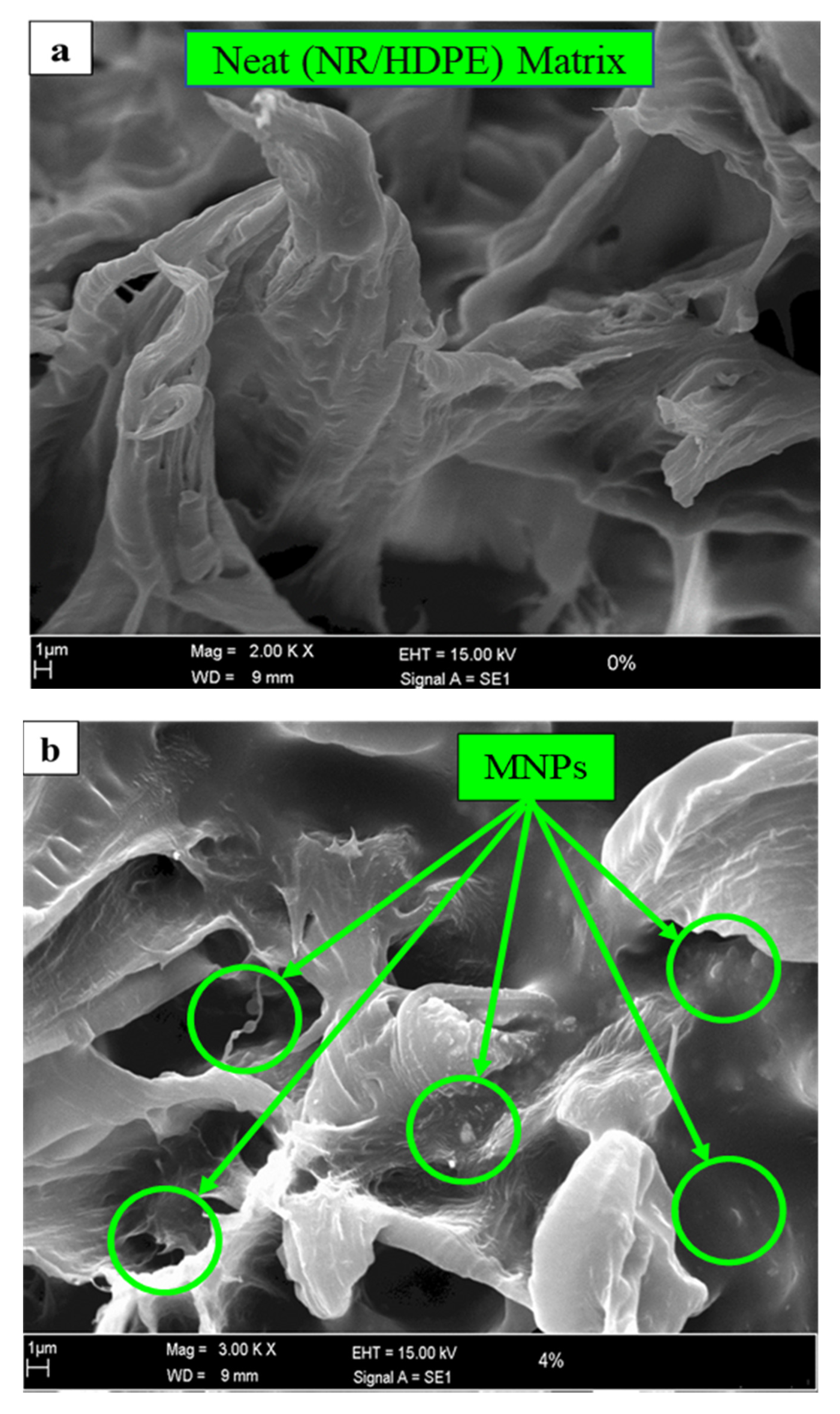
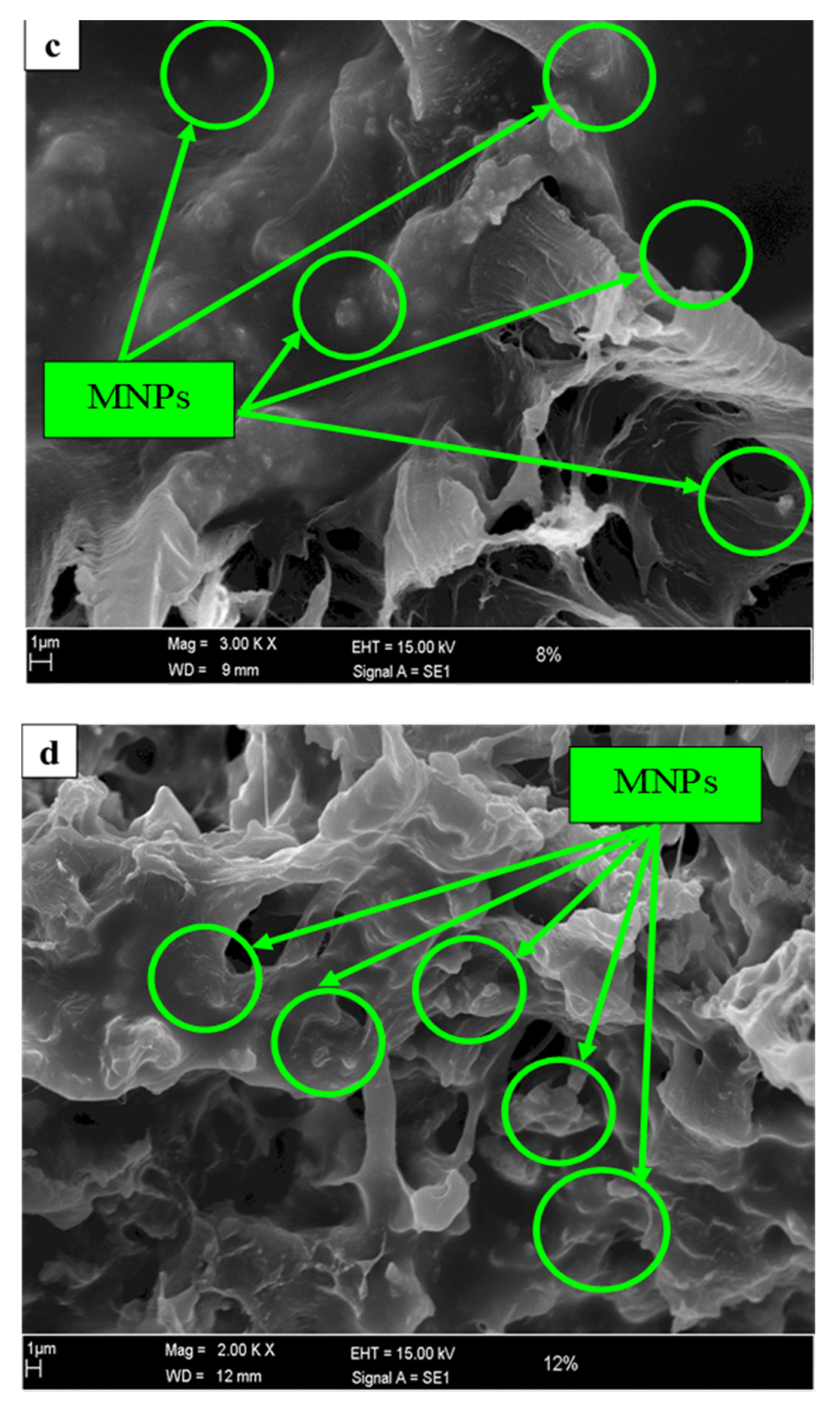
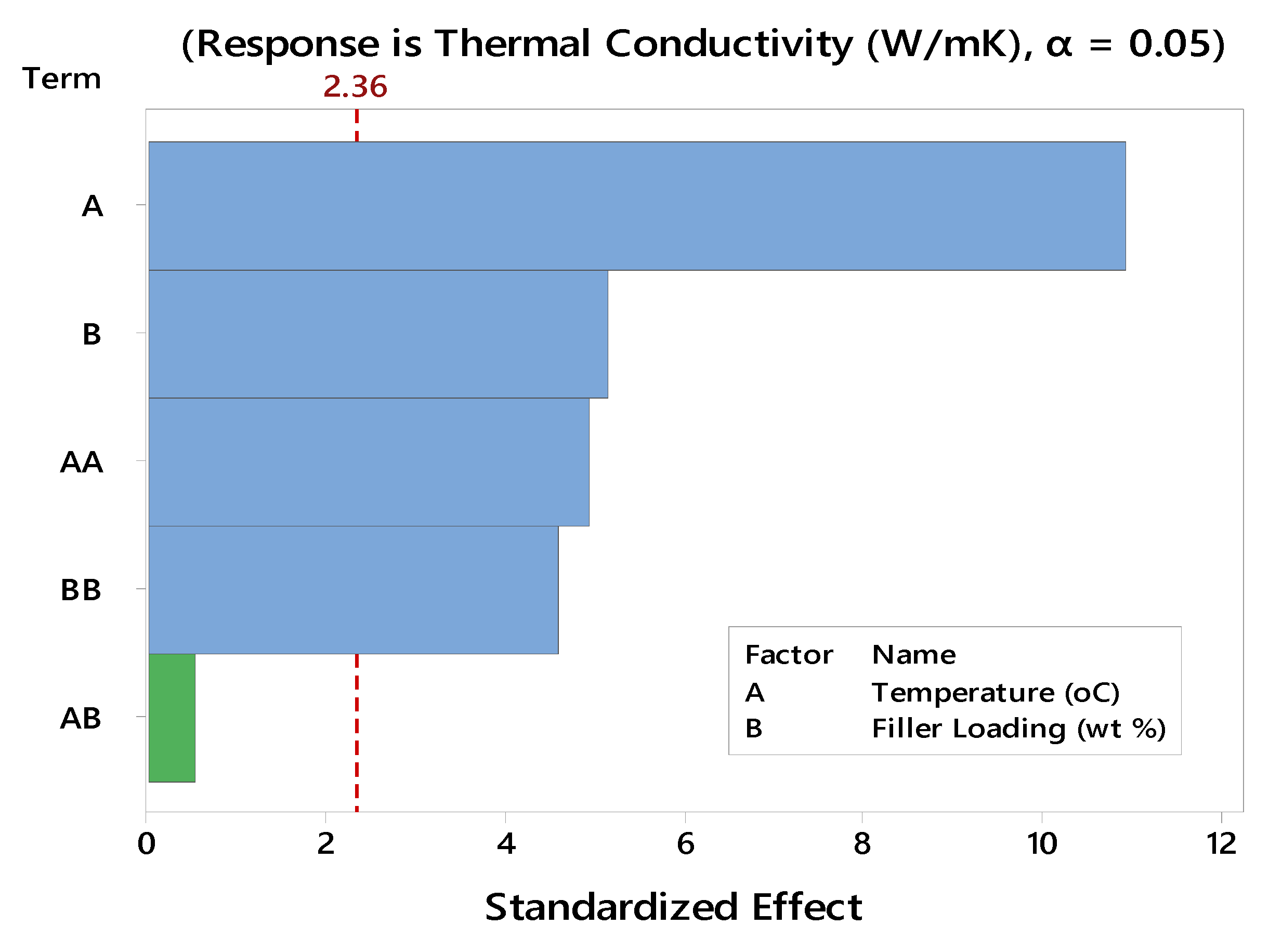
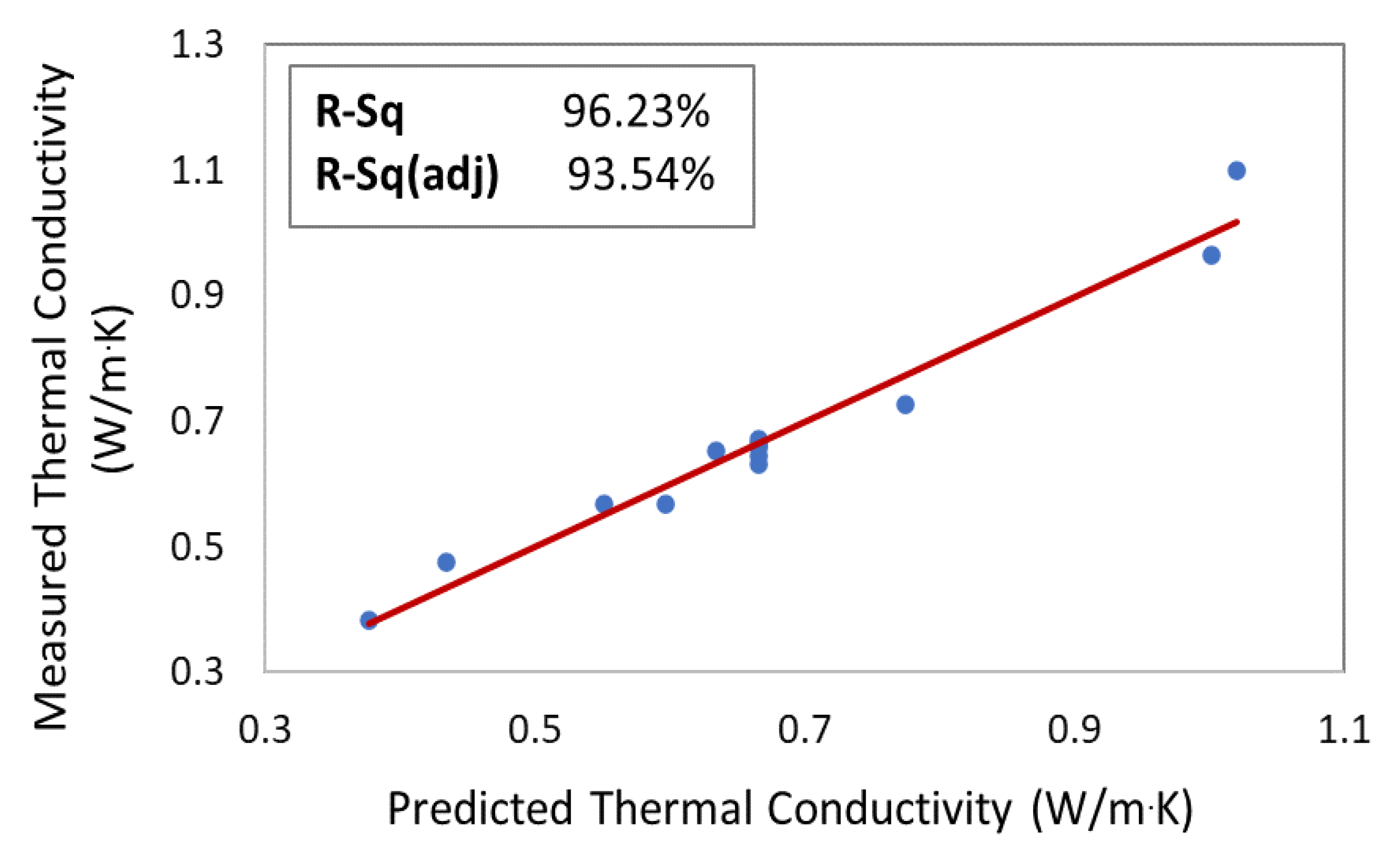
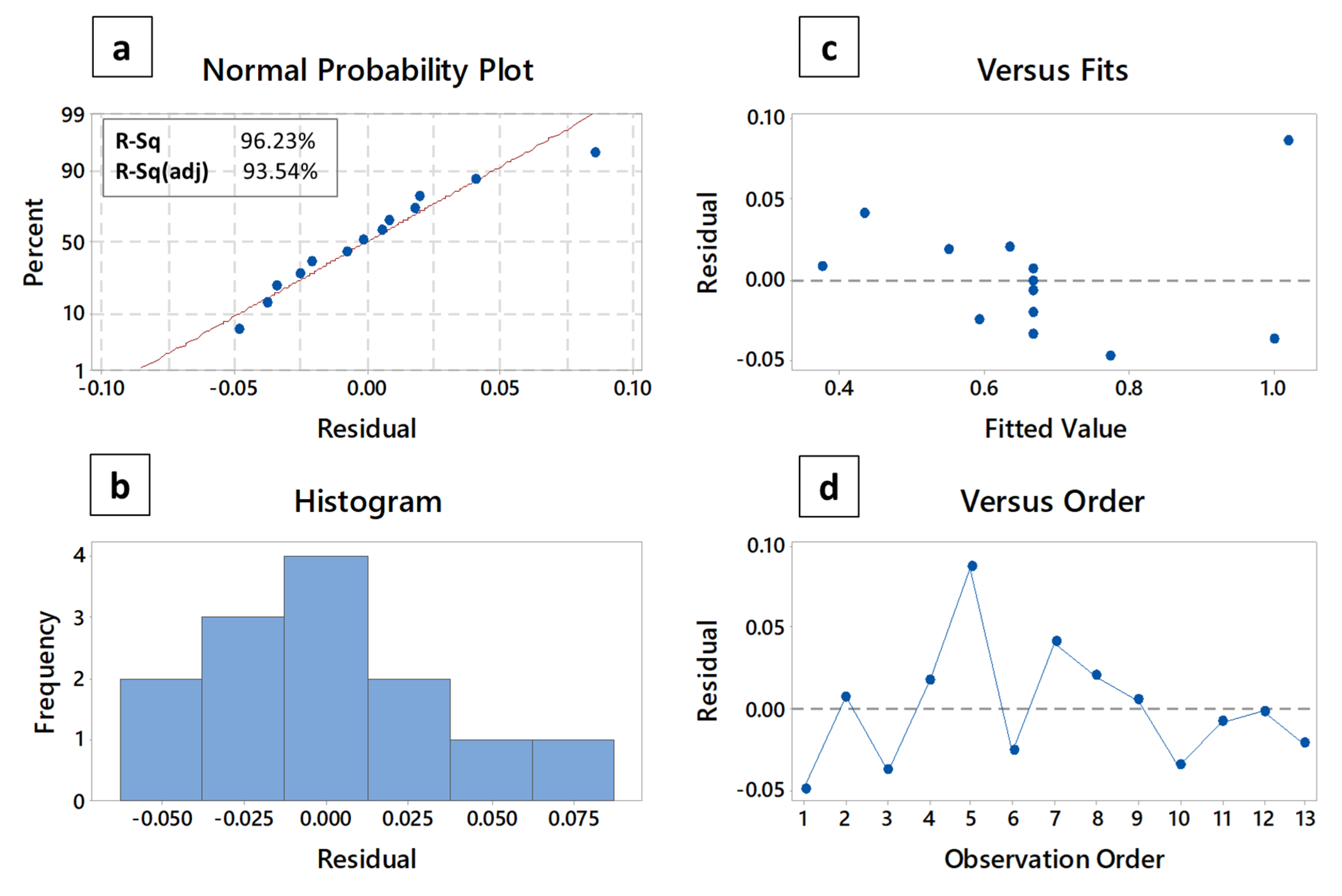

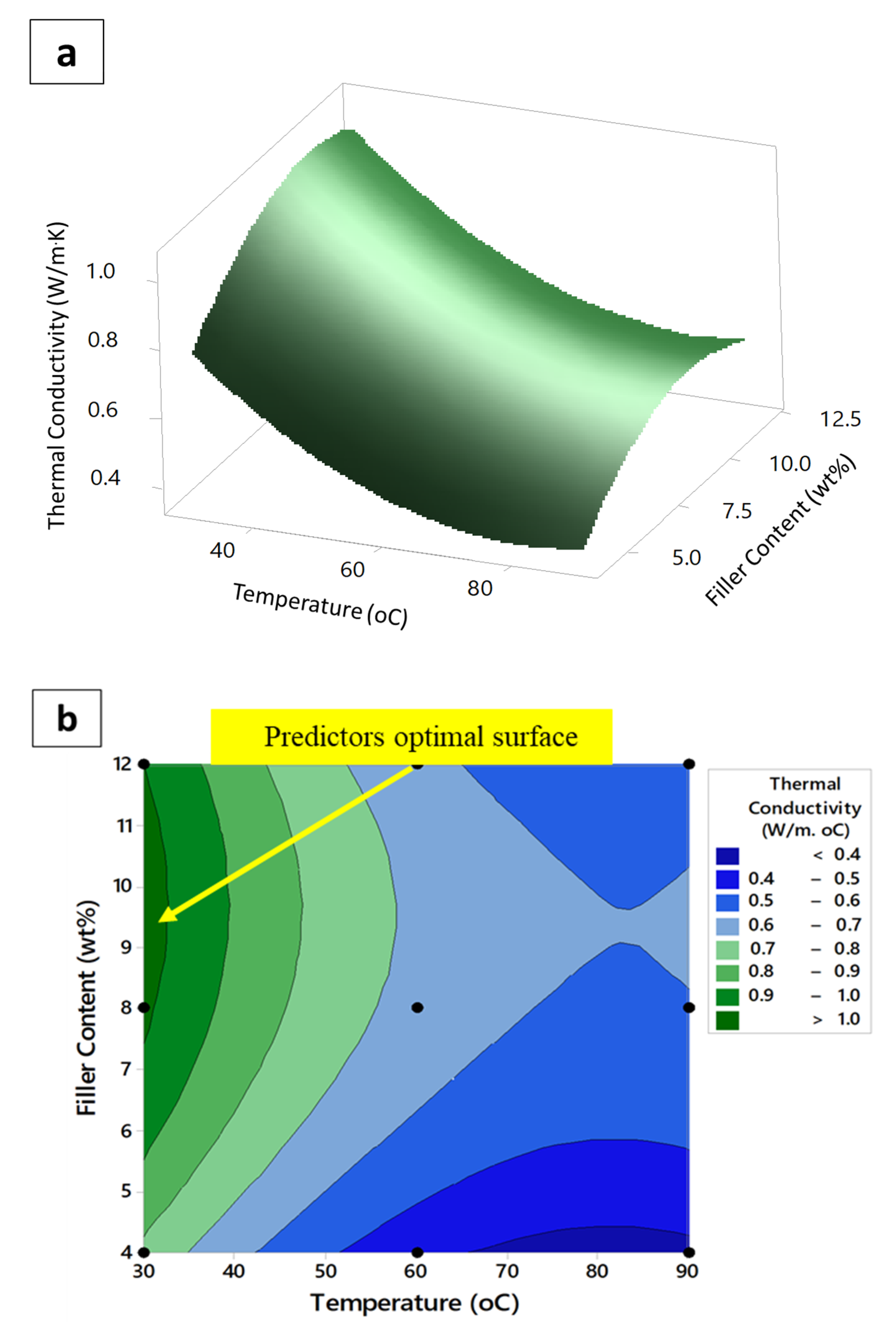
| Sample ID | Point Type | Temperature | Filler Content |
|---|---|---|---|
| 1 | Factorial | −1 | −1 |
| 2 | Factorial | 1 | −1 |
| 3 | Factorial | −1 | 1 |
| 4 | Factorial | 1 | 1 |
| 5 | Axial | −1 | 0 |
| 6 | Axial | 1 | 0 |
| 7 | Axial | 0 | −1 |
| 8 | Axial | 0 | 1 |
| 9 | Centre | 0 | 0 |
| 10 | Centre | 0 | 0 |
| 11 | Centre | 0 | 0 |
| 12 | Centre | 0 | 0 |
| 13 | Centre | 0 | 0 |
| Element | 4 wt% | 8 wt% | 12 wt% | |||
|---|---|---|---|---|---|---|
| wt% | Atomic % | wt% | Atomic % | wt% | Atomic % | |
| C | 66.57 | 76.85 | 47.39 | 68.93 | 35.61 | 54.72 |
| O | 24.18 | 20.96 | 19.24 | 21.01 | 29.75 | 34.32 |
| Fe | 5.19 | 1.29 | 21.82 | 6.83 | 20.36 | 6.73 |
| Ni | 1.74 | 0.41 | 4.98 | 1.48 | 6.09 | 1.91 |
| Zn | 2.32 | 0.49 | 6.58 | 1.76 | 8.19 | 2.31 |
| Sample ID | Coded Temperature | Coded Filler Content | Temperature (°C) | Filler Content (wt%) | Thermal Conductivity (W/m·K) |
|---|---|---|---|---|---|
| 1 | 0 | 0 | 60 | 8 | 0.6706 |
| 2 | 1 | 1 | 90 | 12 | 0.567 |
| 3 | −1 | −1 | 30 | 4 | 0.7268 |
| 4 | 0 | −1 | 60 | 4 | 0.4739 |
| 5 | −1 | 1 | 30 | 12 | 0.9641 |
| 6 | 0 | 0 | 60 | 8 | 0.6639 |
| 7 | 0 | 0 | 60 | 8 | 0.6438 |
| 8 | 0 | 1 | 60 | 12 | 0.6535 |
| 9 | 0 | 0 | 60 | 8 | 0.6304 |
| 10 | −1 | 0 | 30 | 8 | 1.064 |
| 11 | 1 | −1 | 90 | 4 | 0.3824 |
| 12 | 0 | 0 | 60 | 8 | 0.6572 |
| 13 | 1 | 0 | 90 | 8 | 0.5683 |
| Source | Degrees of Freedom | Adjusted Sum of Square | Adjusted Mean of Square | F-Value | p-Value |
|---|---|---|---|---|---|
| Model | 5 | 0.408995 | 0.081799 | 35.74 | 0.000 |
| Linear | 2 | 0.333196 | 0.166598 | 72.79 | 0.000 |
| Temperature (°C) | 1 | 0.272896 | 0.272896 | 119.24 | 0.000 |
| Filler Loading (wt%) | 1 | 0.060300 | 0.060300 | 26.35 | 0.001 |
| Square | 2 | 0.075104 | 0.037552 | 16.41 | 0.002 |
| Temperature (°C) * Temperature (°C) | 1 | 0.055523 | 0.055523 | 24.26 | 0.002 |
| Filler Loading (wt%) * Filler Loading (wt%) | 1 | 0.048024 | 0.048024 | 20.98 | 0.003 |
| 2-Way Interaction | 1 | 0.000694 | 0.000694 | 0.30 | 0.599 |
| Temperature (°C) * Filler Loading (wt%) | 1 | 0.000694 | 0.000694 | 0.30 | 0.599 |
| Error | 7 | 0.016020 | 0.002289 | - | - |
| Lack-of-Fit | 3 | 0.014979 | 0.004993 | 19.18 | 0.008 |
| Pure Error | 4 | 0.001041 | 0.000260 | - | - |
| Total | 12 | 0.425015 | - | - | - |
| Temperature Optimal Value (°C) | Filler Content Optimal Value (wt%) | Optimized Experimental Thermal Conductivity (W/m·K) | Optimized Predicted Thermal Conductivity (W/m·K) | Error % |
|---|---|---|---|---|
| 30 | 9.7 | 1.10 | 1.05 | 4.8 |
© 2020 by the author. Licensee MDPI, Basel, Switzerland. This article is an open access article distributed under the terms and conditions of the Creative Commons Attribution (CC BY) license (http://creativecommons.org/licenses/by/4.0/).
Share and Cite
Flaifel, M.H. An Approach Towards Optimization Appraisal of Thermal Conductivity of Magnetic Thermoplastic Elastomeric Nanocomposites Using Response Surface Methodology. Polymers 2020, 12, 2030. https://doi.org/10.3390/polym12092030
Flaifel MH. An Approach Towards Optimization Appraisal of Thermal Conductivity of Magnetic Thermoplastic Elastomeric Nanocomposites Using Response Surface Methodology. Polymers. 2020; 12(9):2030. https://doi.org/10.3390/polym12092030
Chicago/Turabian StyleFlaifel, Moayad Husein. 2020. "An Approach Towards Optimization Appraisal of Thermal Conductivity of Magnetic Thermoplastic Elastomeric Nanocomposites Using Response Surface Methodology" Polymers 12, no. 9: 2030. https://doi.org/10.3390/polym12092030
APA StyleFlaifel, M. H. (2020). An Approach Towards Optimization Appraisal of Thermal Conductivity of Magnetic Thermoplastic Elastomeric Nanocomposites Using Response Surface Methodology. Polymers, 12(9), 2030. https://doi.org/10.3390/polym12092030





